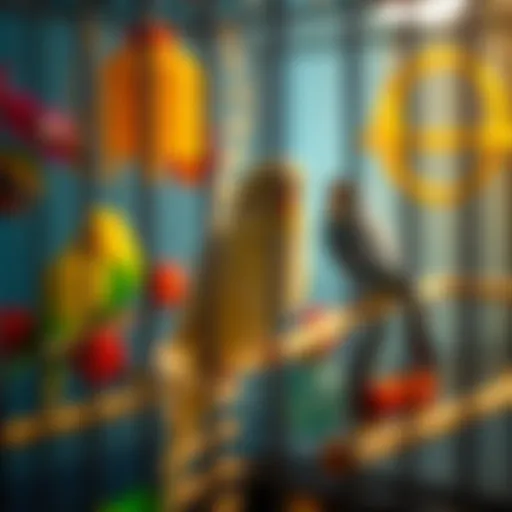Comprehensive Guide to Parakeet Cages for Two Birds
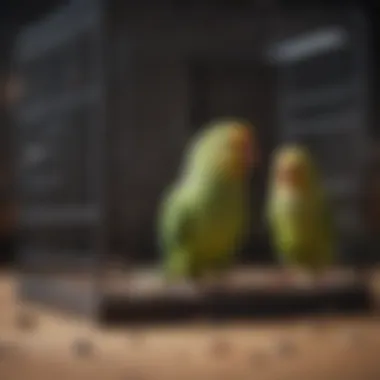

Intro
Selecting the right cage for two parakeets is a task that requires careful consideration. Parakeets, when housed together, can exhibit enriched behavior and companionship. However, ensuring their well-being involves understanding their spatial requirements, social needs, and the appropriate accessories. This guide aims to provide detailed insights into choosing a suitable cage while maintaining a thriving environment for your feathered friends.
Choosing the Right Cage
When selecting a cage for two parakeets, there are several vital criteria to consider. Spacing is critical. The cage dimensions should allow enough room for both birds to move freely and interact without feeling cramped. A horizontal rather than vertical design is preferable, as this layout provides more places to play and perch.
Minimum Size Recommendations
For two parakeets, a minimum size of 36 inches long, 24 inches wide, and 18 inches high is advisable. This ensures they have enough space for their activities. Larger cages will provide more comfort and options for various accessories, thus promoting a healthier atmosphere.
Bar Spacing and Material Considerations
Bar spacing should generally be around 1/2 inch to 5/8 inch to prevent the birds from escaping or getting stuck. Metal cages, while typically more durable, should have a non-toxic finish. Avoid cages made from soft metals, as these may pose a risk of chewing and ingesting harmful materials.
Design Features
A well-designed cage can greatly affect the happiness and health of your parakeets. The following features should be prioritized:
- Multiple Perches: Different heights and types of perches can aid in preventing foot problems.
- Placement of Food and Water: These essentials should be easily accessible yet positioned to avoid contamination from droppings.
- Enrichment Areas: Include swings and toys that encourage natural behaviors.
Essential Accessories
Essential accessories will create a more engaging environment for both parakeets:
- Food and Water Dishes: Choose stable dishes to prevent spills.
- Toys: Rotate toys to keep the birds stimulated.
- Caves or Hiding Spots: These will provide them with a sense of security, essential for well-being.
"Creating the right environment goes beyond choosing a cage; it is about crafting a living space that supports social interaction, exercise, and mental health."
Cleaning Supplies
Keeping the cage clean is paramount to your birds’ health. Use non-toxic cleaning supplies and ensure regular maintenance schedules to manage health risks effectively. Pay special attention to corners and hidden areas that can harbor bacteria or mold.
Health Implications
Housing parakeets together can diminish loneliness, but it also necessitates close monitoring of their health and interactions. Sickness can spread quickly between birds, so regular veterinary check-ups are advisable. This ensures that they are monitored for common health issues such as feather plucking or respiratory problems, which could arise in close quarters.
Providing an enriched environment and ensuring regular check-ups can help mitigate these issues, making the transition to group living more successful.
Epilogue
Understanding how to provide an optimal cage and environment for two parakeets goes a long way in ensuring a fulfilling life for both. While the right cage is a foundation, ongoing care, and awareness are key to nurturing their health and happiness.
Understanding Parakeets as Companion Birds
Understanding parakeets as companion birds is essential for future parakeet owners. Their behaviors, origins, and social dynamics shape how we can provide a suitable environment for them in captivity. A holistic view on the nature and needs of these birds helps ensure that both pet owners and their feathered companions thrive together.
Origin and Natural Habitat
Parakeets, particularly the popular budgerigar species, come from Australia. In the wild, they inhabit open forest areas, grasslands, and deserts. These environments are crucial in understanding their need for space and social interaction. Parakeets are naturally nomadic, often traveling in flocks. This instinct emphasizes the importance of companionship, highlighting that they are not solitary creatures.
Providing them an environment that mirrors their natural habitat increases their comfort and well-being. Cages that are too small can lead to stress and behavioral issues, reinforcing the idea that knowing their origin is key to proper care.
Social Behavior and Bonding
Parakeets are inherently social birds. They thrive on interaction, not just with humans, but with other birds as well. In a shared cage, they provide emotional support to each other, reducing loneliness and boredom. Observing their social behavior is fascinating. They engage in grooming, vocal communication, and playful antics, which are all part of their bonding process.
For owners, recognizing these behaviors can be useful. If one bird seems withdrawn, it may require more interaction or even a new companion. The dynamic between two parakeets can illuminate a lot about their mood and overall health.
Choosing Companions for Your Parakeets
When selecting additional parakeets, compatibility is crucial. Some factors to consider include age, size, and temperament. Parakeets can exhibit territorial behavior, especially if they feel their space is invaded. It is essential to introduce new birds gradually. Start with short meetings in a neutral space before bringing them into the same cage.
Here are some tips for choosing companions:
- Species Match: Ensure the new parakeet is of the same species to minimize conflicts.
- Age Similarity: Birds of similar ages tend to interact better.
- Personality Type: Match more dominant birds with those that are less assertive to create a balance.
Selecting the right companions for parakeets enriches their lives and enhances their well-being.
Cage Specifications for Parakeets
When choosing a cage for two parakeets, specifications play a crucial role in their overall well-being. It is not just about aesthetics but rather how space and structure contribute to their health and happiness. Selecting the right size, bar spacing, materials, and design can lead to enhanced social interactions and satisfying living conditions. Proper cage specifications facilitate exercise, prevent stress, and reduce the risk of injury, thus assuring that your feathered companions can thrive in their environment.
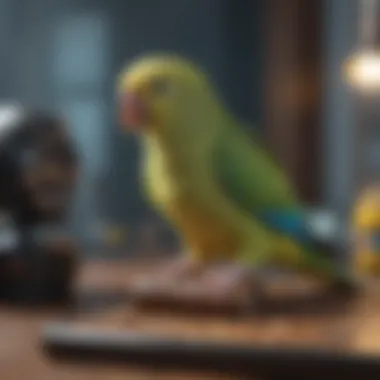

Size Considerations
The importance of cage size cannot be overstated. Parakeets are active creatures that require sufficient space to move around and play. Ideally, cages should be spacious enough for two birds to fly short distances, especially if they are confined for most of the day. A recommended minimum cage dimension is 28 inches in width, 20 inches in depth, and 24 inches in height. However, larger cages are always preferable to offer even more room for roaming and exploring.
Consider the number of levels inside the cage, as well; multi-level cages can maximize vertical space and allow each parakeet to have its own territory. This design encourages natural behaviors such as climbing and exploring.
Bar Spacing and Material
Bar spacing is another critical aspect to examine. For parakeets, the space between bars should ideally be between 3/8 inches and 1/2 inches. Bar spacing that is too wide can pose a risk of escape or injury, while too narrow bar spacing might not allow for comfortable movement. Choosing the right material is equally essential. Cages can be fashioned from stainless steel, coated metal, or plastic. Stainless steel is durable and easy to clean, while coated metals may rust or chip over time. Make sure to select a cage constructed from non-toxic materials.
Cage Shape and Design
The shape and design of the cage can significantly impact your parakeets' quality of life. Rectangular cages provide the most options for interior layout and can accommodate perches, toys, and food dishes. Avoid round or small cages, as these limit space and do not allow for efficient movement.
Additionally, the design should accommodate proper ventilation and light. Cages with horizontal bars usually allow for easier climbing, which is beneficial for bird exercise. Ensure that the cage has a secure locking mechanism to prevent any chances of unintended escape.
It is best to prioritize your parakeets’ comfort and safety through thoughtful cage specifications. Creating an optimal housing environment is essential for their overall health and behavior.
Essential Accessories for a Dual-Parakeet Cage
Creating a suitable habitat for two parakeets goes beyond just choosing the right cage. It is essential to equip the cage with accessories that promote comfort, health, and social interaction. The right accessories can significantly enhance the quality of life for your birds. This section will discuss key elements like perches, food and water dishes, and toys, all of which contribute to a thriving environment for your feathered companions.
Perches: Types and Placement
Perches are vital for the well-being of parakeets. They offer a space for resting and exercising. It's important to provide perches of varying materials and thickness. Natural wood perches, for instance, mimic the birds’ natural habitat. They encourage foot health by allowing the birds to exercise their feet.
Placement is also crucial. Arrange perches at different heights to create a dynamic environment. This encourages climbing and helps the birds feel secure by providing spots to retreat if they feel threatened. Avoid placing perches directly above food and water dishes, as waste may contaminate their supplies.
Food and Water Dishes
Proper nutrition is critical for parakeets. Having separate food and water dishes is recommended. This prevents food from contaminating the water supply. Opt for sturdy, easy-to-clean dishes that minimize spillage.
Material matters; stainless steel dishes are often preferred as they are durable and easy to sanitize. Ensure the dishes are securely attached to the cage. This prevents the birds from tipping them over. Monitor their food intake daily, as it helps in observing any dietary changes or health issues.
The combination of a balanced diet with clean water is essential for the vibrancy of your birds.
Toys for Mental Stimulation
Mental stimulation is as crucial as physical activity. Provide a variety of toys that can engage and entertain your parakeets. Toys made from natural materials, such as ropes, wood, and paper, are great options. Swinging toys, bells, and mirrors can also contribute to mental health by encouraging play and curiosity.
Rotation is key; regularly change the toys to maintain interest. Observing which toys your parakeets prefer can also help in understanding their personality. Engaging them in play prevents boredom, which can lead to behavioral issues, such as feather plucking or aggression towards cage mates.
In summary, the accessories within a dual-parakeet cage are fundamental. They provide not just basic needs, but also a stimulating environment that enhances your birds' overall well-being. Ensuring the right resources will lead to healthier and happier parakeets.
Cage Maintenance for Optimal Health
Cage maintenance is a fundamental aspect of ensuring the long-term health and happiness of your parakeets. A clean environment not only promotes physical well-being but also contributes to their mental happiness. Regular upkeep of the cage can prevent various health issues, including respiratory problems, skin irritations, and infections. Parents of parakeets should regard their cages as both a home for their birds and a critical area that requires consistent attention.
Daily Cleaning Routines
Implementing a daily cleaning routine is crucial for maintaining hygiene in the cage. This routine should include:
- Removing Droppings: Parakeet droppings can accumulate quickly and create a messy environment. Use a small scoop or paper towel to clean the area thoroughly each day, focusing on perches and the cage floor.
- Wiping Down Surfaces: Use a damp cloth to wipe down the bars and surfaces of the cage to prevent the build-up of dirt and debris. Avoid harsh chemicals; a mixture of water and vinegar can be effective and safe.
- Changing Food and Water: Ensure that food and water dishes are clean and fresh each day. Replace any uneaten food to prevent spoilage and bacterial growth.
By taking these small steps daily, you create a cleaner and healthier living space for your birds.
Deep Cleaning: Frequency and Methods
Deep cleaning is a more intensive process that should be completed on a bi-weekly or monthly basis. This involves a thorough examination and cleaning of the entire cage setup.
- Remove All Accessories: Take out perches, dishes, and toys. Cleaning these items separately will ensure they are not neglected.
- Use Safe Cleaning Solutions: A solution like diluted dish soap or a bird-safe cleaner can help to sanitize the cage without harming your pets. Rinse thoroughly to remove any residues.
- Clean the Base and Corners: Pay special attention to any hard-to-reach corners that may trap more dirt.
Monitoring Hygiene and Disease Prevention
Monitoring the hygiene of the cage can prevent the spread of disease among your parakeets. Regularly observing your birds for signs of illness is equally important.
- Check for Signs of Dirt or Mold: Regularly look for mold in food dishes or droppings that remain too long, which can lead to health hazards.
- Observe Behavioral Changes: Changes in your birds' behavior can indicate stress or health issues related to their environment. Watch for signs like reduced activity, changes in vocalization, or altered eating habits.
- Limit Exposure to Contaminants: Avoid placing the cage in areas where it might be exposed to smoke, harsh chemicals, or excessive dust.
"A clean cage is a happy cage. Maintaining hygiene in a parakeet’s living space is pivotal for their health and comfort."
By adhering to a systematic cleaning regimen and monitoring the health of your birds, you can create a thriving environment conducive to their overall well-being. The effort put into cage maintenance is directly reflected in the happiness and longevity of your parakeets.
Acclimatizing New Birds to Their Cage
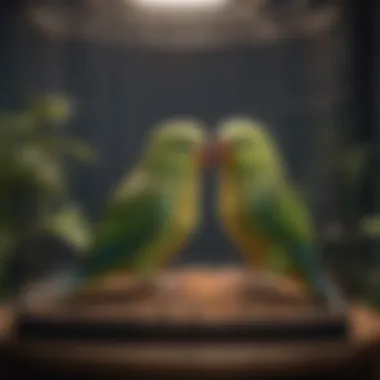

Acclimatizing new parakeets to their cage is a crucial step in ensuring their comfort and welfare. This process helps ease the transition from their previous environment to a new one. Birds are creatures of habit, and changing their surroundings can cause stress and anxiety. A well-executed acclimatization strategy will not only reduce potential behavioral issues but also promote positive interactions between the birds and their new habitat.
Intro Techniques for New Parakeets
When introducing new parakeets to their cage, the approach is vital. Gradual exposure allows them to adjust without feeling overwhelmed. Start by placing the cage in a quiet room, away from loud noises and direct sunlight. This way, they can explore their new home in relative peace. Open the cage door and allow them to enter on their own terms.
Utilizing treat reinforcement can also be beneficial. Offer seeds or favorite snacks as incentives for them to come out. It creates a positive association with the new environment. Be patient, as rushing this process can lead to fear and reluctance to explore.
Understanding Initial Behavioral Signs
Monitoring the birds' initial behaviors is essential to assess their comfort level. Signs that the birds are adapting include curiosity and exploration of their surroundings. Birds may move around, peck at objects, and perch comfortably. Conversely, if they puff up their feathers, remain silent, or hide, it indicates discomfort.
It is crucial to observe interactions between the two parakeets as well. A healthy bond may be exemplified through preening each other or vocalizing together. If one bird shows dominance or aggression, prompt intervention might be necessary to manage any conflicts.
Creating a Safe Environment
A safe environment is paramount for a successful transition. Ensure that the cage is free of hazards such as sharp objects or toxic plants. Additionally, ensure proper perching and resting places are available for the birds. A comfortable environment promotes relaxation, allowing birds to settle in more comfortably.
Consider placing a few hiding spots within the cage. Small boxes or hanging greenery can provide parakeets with areas to retreat to when feeling vulnerable. This fosters a sense of security during their initial days in a new space.
Ensuring a smooth transition for new parakeets will greatly contribute to their overall well-being and happiness.
Observing Interactions Between Two Parakeets
Understanding the relationships between your parakeets is crucial for their well-being and happiness. Observing interactions allows you to recognize their social dynamics, ensuring that they coexist peacefully. Monitoring their behaviors can provide insight into their mental health and overall compatibility.
Signs of Healthy Interaction
Recognizing signs of healthy interaction is essential for ensuring that both parakeets thrive in their environment. Healthy interactions include:
- Mutual preening: This act helps to strengthen bonds between birds, showing trust and affection.
- Playful behavior: Engaging in play, such as chasing or swinging together, is a positive sign of their comfort with each other.
- Synchronized movements: When they move together, it often indicates a harmonious relationship.
A harmonious bond leads to less stress for both birds. They benefit from companionship, which can reduce loneliness when they are not engaging with humans.
Identifying Conflict and Aggression
Even in pairs that appear well-matched, conflicts can arise. Identifying early signs of aggression is important to prevent potential harm. Some behaviors to watch for include:
- Loud squawking: Sudden loud sounds can indicate distress or irritation.
- Physical aggression: Beaks are strong. If one bird is regularly attacking or biting the other, this must be addressed.
- Territorial behavior: One parakeet may claim areas in the cage or refuse to share resources, indicating ownership issues.
Observing these behaviors helps you intervene before small issues escalate into serious conflict.
Intervention Strategies for Behavioral Issues
When conflict is evident, taking action is necessary to restore harmony. Consider the following strategies:
- Separate the birds temporarily: Allowing them space can help to reduce tension and prevent aggression.
- Adjust cage setup: Providing more perches, food, and water stations can prevent competition, reducing stress on both birds.
- Monitor interactions closely: Keep a watchful eye on their interactions after reintroducing them to ensure they have settled back into a positive routine.
It’s important to remember that every parakeet has its personality. Patience and understanding of their unique behaviors will foster a better living environment.
By taking the time to observe and understand these interactions, you will ensure a closer bond between your parakeets, reinforcing their mutual companionship.
Feeding Guidelines for Two Parakeets
Feeding guidelines play a crucial role in maintaining the health and happiness of your parakeets. With two birds sharing a cage, it is important to understand how their dietary needs can affect their well-being. A proper feeding regime not only ensures they receive the right nutrients, but it also promotes social bonding and minimizes conflict over food. By establishing efficient feeding strategies, you can help create a harmonious living environment for your feathered friends.
Balanced Diet Considerations
A balanced diet is essential for the overall health of parakeets. Just like humans, birds require a variety of nutrients. The main components of a balanced diet for parakeets include high-quality seeds, pellets, fresh fruits, and vegetables.
- Seeds: While seeds can provide essential fats and proteins, they should not be the only food source. The high-fat content can lead to obesity if consumed in excess.
- Pellets: Commercial parakeet pellets are often formulated with the needed vitamins and minerals. Incorporating these into their diet can help ensure that they receive a more complete nutritional profile.
- Fruits and Vegetables: Adding fresh fruit and vegetables can introduce essential vitamins. Dark leafy greens, carrots, and apples are good selections. Always introduce new foods gradually and observe for any digestive issues.
This variety in their diet not only supports physiological health but also keeps their meals interesting.
Managing Food Portions and Availability
Managing the portions and availability of food is crucial, especially in a multi-bird environment. Here are some important points to consider:
- Feeding Schedule: Establish a consistent feeding routine. Providing food at the same time each day can create a sense of security for the birds.
- Portion Control: Overfeeding can lead to waste and health problems. A general rule is to provide about one tablespoon of seeds or pellets per bird daily, adjusting based on their appetite and activity level.
- Multiple Feeding Stations: To avoid competition between the birds, offer multiple feeding stations. This allows both birds to eat simultaneously without feeling threatened or overly dominant.
By applying these strategies, you can reduce stress during mealtime.
Supplementary Treats and Their Role
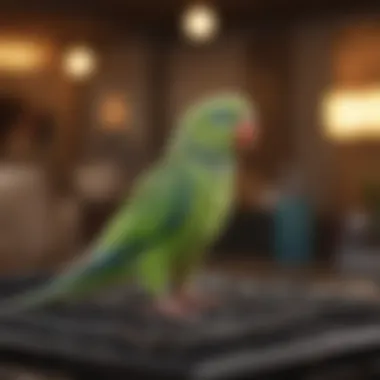

Supplementary treats can enhance your parakeets’ diet and mental stimulation. When used correctly, treats serve as positive reinforcement and bonding opportunities.
- Treat Types: Healthy treats can include nuts, seeds, or specially formulated bird treats. Avoid sugary options or processed foods as these can lead to health issues.
- Usage: Treats should not exceed 10% of their total diet. Use them sparingly to maintain their interest.
- Training: Incorporate treats into training sessions. This can improve interaction and help develop trust between you and your birds.
Providing a well-thought-out diet is vital for the longevity and happiness of your parakeets.
By focusing on a balanced diet, managing portions, and choosing appropriate treats, you will significantly enhance the well-being of your parakeets. Their diet can greatly impact their behavior, health, and overall quality of life.
Health Monitoring in Parakeets
Health monitoring is a crucial aspect of caring for parakeets, especially when housing multiple birds. Regular checks ensure that both birds remain vibrant and active. Monitoring their health is not only about preventing disease but also about fostering a happy and comfortable environment.
Routine health assessments help in early detection of any potential issues. This is important because parakeets often disguise their symptoms until the illness becomes serious. Consequently, understanding and implementing health monitoring practices can make a significant difference in their well-being.
Routine Health Checks
Conducting routine health checks is essential in ensuring your parakeets remain in optimal health. Aim to perform these checks at least once a week. Here are key aspects to focus on during your examination:
- Feather condition: Look for bald patches or signs of excessive molting, which could indicate stress or nutritional deficiencies.
- Weight assessment: Regularly weigh your birds to ensure they are maintaining a healthy weight. A sudden gain or loss can signal potential health problems.
- Beak and nails: Trim them if they grow too long. Check for any abnormalities, such as cracks or discoloration.
- Eyes and nostrils: Observe for any discharge, swelling, or signs of infection.
- Behavioral observations: Sudden changes in behavior, such as decreased activity or unusual vocalizations, can signal issues.
Signs of Illness and Distress
Recognizing signs of illness in parakeets is crucial for timely intervention. Some common indicators include:
- Fluffed feathers: A bird with fluffed feathers may be feeling unwell or cold.
- Lethargy: If the bird is less active than usual or spends more time sitting than playing, this is concerning.
- Changes in appetite: A decline in food or water intake often indicates health issues.
- Vomiting or diarrhea: These symptoms are not normal and require immediate attention.
- Excessive scratching or biting at feathers: This behavior may indicate skin conditions or mites.
It is vital to observe these signs closely and take appropriate action when necessary.
When to Consult a Veterinarian
Knowing when to seek professional help is essential in managing your parakeet's health. Visit a veterinarian if you notice:
- Persistent lethargy or weakness that lasts for more than a day.
- Any concerning behavioral changes that do not resolve quickly.
- Severe weight loss or gain over a short period.
- Signs of trauma, such as difficulty flying or visible injuries.
In general, establishing a relationship with an avian veterinarian can help provide peace of mind. They can offer insight on how to keep your birds healthy and may advise on regular check-ups.
Maintaining vigilant health monitoring will significantly contribute to the longevity and happiness of your parakeets. The earlier you identify potential health issues, the better the chances of successfully addressing them.
Legal and Ethical Considerations
In caring for parakeets, pet owners have certain responsibilities that extend beyond basic care tasks. Legal and ethical considerations are not often highlighted but are crucial for the well-being of your birds. Understanding the governing rules related to ownership ensures compliance and fosters a conducive environment for parakeets. Furthermore, ethical considerations promote the responsibility of providing a healthy and humane life for these animals.
Understanding Ownership Regulations
Responsible ownership begins with being informed about local laws. Owning parakeets can involve specific permits or regulations, depending on your area. Some locations may categorize certain breeds as exotic, requiring you to adhere to additional guidelines. These regulations often aim to protect both the birds and potential wild populations from harm.
- Permits: Check if you need a permit for ownership. In some regions, certain species of parakeets need special authorizations.
- Zoning Laws: Local zoning ordinances may dictate how many birds you can keep. Be mindful of these limits to avoid local fines.
- Animal Welfare Standards: Many areas have laws protecting pets from neglect or abuse, ensuring basic welfare needs are met.
Ensuring adherence to these regulations not only prevents potential legal conflict but also supports community standards regarding animal care. It reflects on the owner's commitment to responsible pet ownership.
Breeding and Genetic Considerations
When considering breeding parakeets, it is essential to understand the ethical implications attached. Breeding should not be done lightly. Thorough knowledge of genetics is vital.
- Genetic Diversity: Maintaining genetic diversity is crucial for the health of the population. Breeding closely related birds can lead to health issues.
- Ethical Breeding Practices: Aim to breed for health and temperament rather than solely for profit. This involves selecting the right mates and ensuring minimal stress during the breeding process.
- Consideration for Homing Excess Birds: If you breed parakeets, plan for what happens to any offspring. Make arrangements for responsible placement, whether through adoption or sale, to avoid unwanted populations.
Remember: Ethical breeding practices ensure that the interests of the birds take precedence over personal or financial gain.
Preparing for Lifespan and Long-Term Commitment
Understanding the lifespan of parakeets is crucial for any owner who wishes to commit to this companionship. Parakeets are not ephemeral pets; they can live between 5 to 15 years, depending on various factors such as genetics, diet, and living conditions. Recognizing the duration of commitment required is the first step in ensuring that you are ready for the responsibility.
Average Lifespan of Parakeets
Parakeets usually have a lifespan that can vary significantly. Smaller species tend to live longer, while some of the larger breeds have a shorter lifespan. Budgerigars, commonly referred to as budgies, are popular and can live about 7 to 15 years when well cared for. However, those that experience stress, ill health, or inadequate diet can fall short of this range.
Environmental factors greatly influence their longevity. A spacious and clean cage, combined with a well-balanced diet, can promote a healthy life. Regular veterinary check-ups are beneficial in identifying potential health issues early.
Long-Term Care Planning
Planning for the long-term care of your parakeets encompasses many dimensions. First, establishing a proper diet is fundamental. A varied diet including high-quality pellets, fresh vegetables and occasional seeds is essential for optimal health.
Environmental enrichment also plays a significant role. Toys, perches, and different activities keep your parakeets engaged. Rotating their toys frequently can stimulate their mental health.
Routine maintenance of their cage and accessories cannot be overlooked. Regular cleaning and inspecting the hardware will prevent health issues related to hygiene. Setting aside time for daily interactions is also vital. Parakeets thrive on social interaction, so they need quality time with their owners.
Another aspect of long-term care is financial planning. Healthcare, food, and purchasing quality accessories can add up. Ensuring that you have the financial means to support their needs over the years can help maintain peace of mind.
"Understanding the needs and commitments of owning parakeets can lead to a fulfilling experience for both the birds and their owners."







